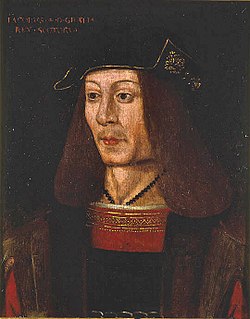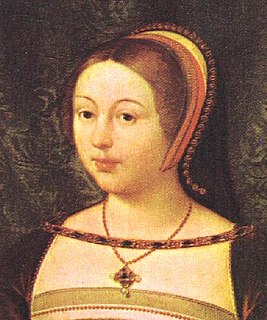
James V was King of Scotland from 9 September 1513 until his death, which followed the Scottish defeat at the Battle of Solway Moss. His only surviving legitimate child, Mary, Queen of Scots, succeeded him when she was just six days old.

James IV was King of Scotland from 11 June 1488 to his death. He assumed the throne following the death of his father King James III at the Battle of Sauchieburn, a rebellion in which the younger James played an indirect role. He is generally regarded as the most successful of the Stewart monarchs of Scotland, but his reign ended in a disastrous defeat at the Battle of Flodden. He was the last monarch from Great Britain to be killed in battle.

Margaret Tudor was Queen consort of Scotland from 1503 until 1513 by marriage to James IV of Scotland and then, after her husband died fighting the English, she became regent for their son James V of Scotland from 1513 until 1515.

Mary of Guise, also called Mary of Lorraine, ruled Scotland as regent from 1554 until her death. A noblewoman from the Lotharingian House of Guise, she played a prominent role in 16th-century French politics. Mary became queen consort upon her marriage to King James V of Scotland in 1538. Their infant daughter, Mary, Queen of Scots, ascended the throne when James died in 1542. Mary of Guise's main goal as regent was a close alliance between the powerful French Catholic nation and smaller Scotland, which she wanted to be Catholic and independent of England. She was ultimately unable to prevent the Protestant Reformation in Scotland, which after her death left her daughter in a precarious position.

Madeleine of France or Madeleine of Valois was a French princess who became Queen of Scotland as the first spouse of King James V. The marriage was arranged as a condition of the Treaty of Rouen, and James was originally to be betrothed to another bride, but he preferred Madeleine. They married, but her health, poor since birth, failed and she died six months after the wedding, resulting in her nickname, the "Summer Queen" of Scots.

James Hamilton, 1st Earl of Arran and 2nd Lord Hamilton was a Scottish nobleman, naval commander and first cousin of James IV of Scotland.

Andrew Forman was a Scottish diplomat and prelate who became Bishop of Moray in 1501, Archbishop of Bourges in France, in 1513, Archbishop of St Andrews in 1514 as well as being Commendator of several monasteries.

John Stewart, Duke of Albany was regent of the Kingdom of Scotland, Duke of Albany in peerage of Scotland and Count of Auvergne and Lauraguais in France.

Robert Cockburn was a 16th-century Scottish diplomat and cleric.

The Treaty of Berwick was negotiated on 27 February 1560 at Berwick-upon-Tweed. It was an agreement made by the representative of Queen Elizabeth I of England, the Duke of Norfolk, and the group of rebellious nobles known as the Scottish Lords of the Congregation. The purpose was to agree the terms under which an English fleet and army would come to Scotland to expel the French troops who were defending the Regency of Mary of Guise. The Lords were trying both to expel the French and to effect the Scottish Reformation, and this led to rioting and armed conflict.

The Auld Alliance was an alliance made in 1295 between the kingdoms of Scotland and France for the purpose of controlling England's numerous invasions. The Scots word auld, meaning old, has become a partly affectionate term for the long-lasting association between the two countries. Although the alliance was never formally revoked, it is considered by some to have ended with the signing of the Treaty of Edinburgh in 1560.

In July 1482 an English army invaded Scotland during the Anglo-Scottish Wars. The town of Berwick-upon-Tweed and its castle were captured and the English army briefly occupied Edinburgh. These events followed the signing of the Treaty of Fotheringhay, 11 June 1482, in which Alexander Stewart, Duke of Albany, the brother of James III of Scotland declared himself King of Scotland and swore loyalty to Edward IV of England. The follow-up invasion of Scotland under the command of Edward's brother, Richard, Duke of Gloucester failed to install Albany on the throne, but Berwick has remained English ever since the castle surrendered on 24 August. The English army left Edinburgh with a promise for the repayment of the dowry paid for the marriage of Princess Cecily of England to the Scottish Prince.

The Rough Wooing was part of the Anglo-Scottish Wars of the 16th century between Scotland and England. Following its break with the Roman Catholic Church, England attacked Scotland, partly to destroy the Auld Alliance and prevent Scotland being used as a springboard for future invasion by France, partly to weaken Scotland, and partly to force Scotland to agree to a marriage alliance between Mary, Queen of Scots, and the English heir apparent Edward, son of King Henry VIII,. An invasion of France was also contemplated. Henry declared war in an attempt to force the Scots to agree to a marriage between Edward, who was six years old at the start of the war, and the infant queen, thereby creating a new alliance between Scotland and England. Upon Edward's accession to the throne in 1547 at the age of nine, the war continued for a time under the direction of the Duke of Somerset, before Somerset's removal from power in 1549 and replacement by the Duke of Northumberland, who wished for a less costly foreign policy than his predecessor. It was the last major conflict between Scotland and England before the Union of the Crowns in 1603, excepting perhaps the English intervention at the Siege of Leith in 1560.
Sir Thomas Erskine of Haltoun and Brechin was the royal secretary to James V of Scotland from 1524.
Patrick Paniter Scottish churchman and principal secretary to James IV of Scotland and the infant James V. The surname is usually written Paniter, or Painter, or occasionally Panter.

Jacques de la Brosse, cupbearer to the king, was a sixteenth-century French soldier and diplomat. He is remembered in Scotland for his missions in 1543 and 1560 in support of the Auld Alliance.

Mary of Bourbon or Marie de Bourbon was a daughter of Charles, Duke of Vendôme, and Françoise d'Alençon, daughter of René, Duke of Alençon. Mary was the subject of marriage negotiations of James V of Scotland. He visited her in France, but subsequently married Madeleine of Valois. Mary died two years later.

Antoine d'Arcy, sieur de la Bastie-sur-Meylan and of Lissieu, was a French nobleman involved in the government of Scotland.
Robert Barton of Over Barnton was a Scottish landowner, merchant, sailor and politician. He served as Comptroller, Master of the Mint and Lord High Treasurer to James V of Scotland.
Sir William Hamilton of Sanquhar was pursemaster for James V and the Captain of Edinburgh Castle during the Regency of Regent Arran